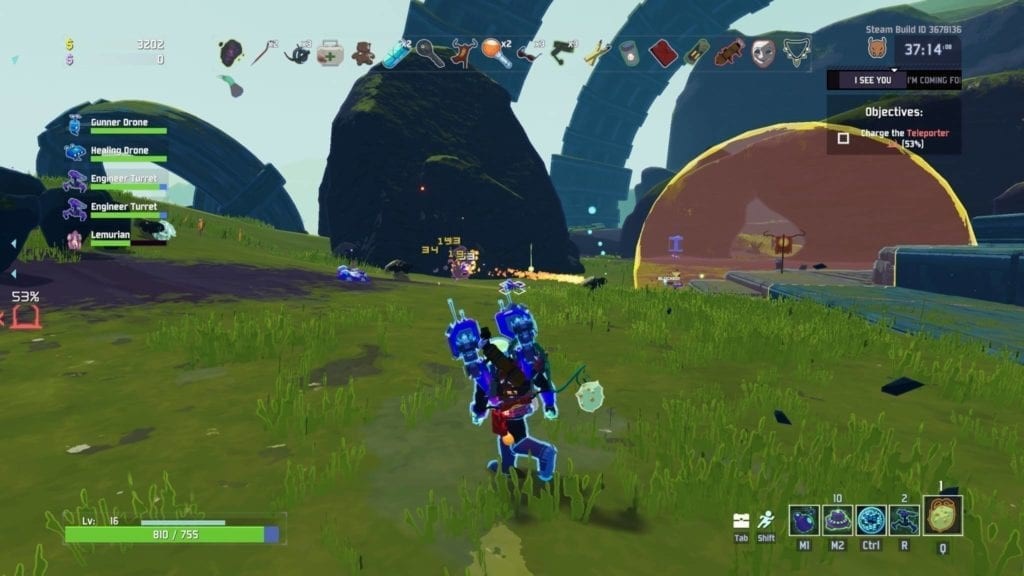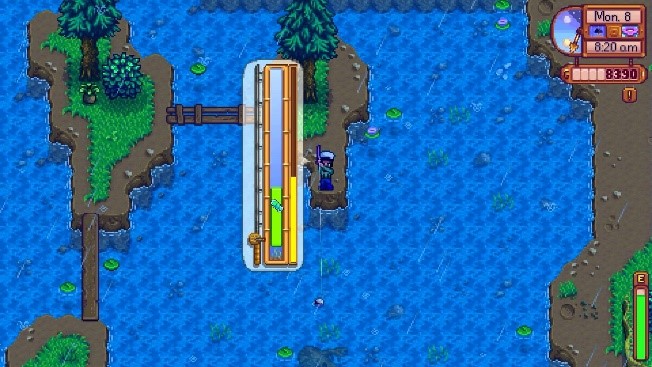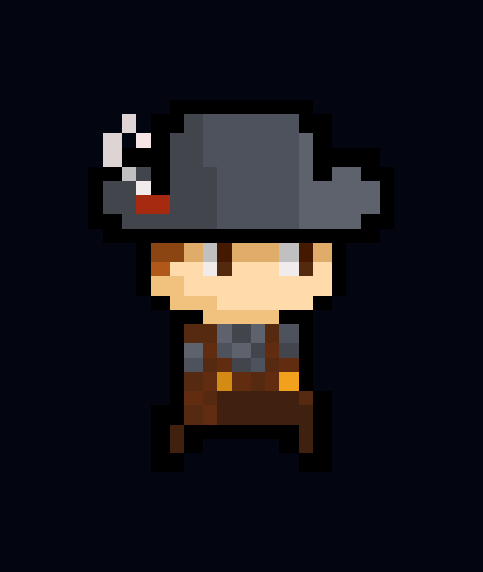The Lonseome Fisherman Concept DevLog
The Lonesome Fisherman
Concept Statement:
When returning from a routine fishing trip, a lonesome fisherman uncovers the dark secrets lurking beneath the surface of his world. Face off against sinister mythical creatures, catch mysterious fish and discover the enchanted treasures in a seemingly never-ending web of caves.
Concept Creation Process:
The concept for this game was developed with many ideas in mind. It contains a wide variety of gameplay features from games of similar genres, juxtaposed to mechanics derived from games with exceptionally different characteristics. It takes these inspirations and mashes them together to explore an innovative and fresh interpretation of the ever-growing list of similar games. Most significantly “The Lonesome Fisherman” integrates the fast-paced and action-packed gameplay of games such as: “Risk of Rain 2” (Hopoo Games, 2019) [1] and “Enter the Gungeon” (Dodge Roll, 2016) [2]. These two games focus heavily on being difficult and fast-paced, requiring quick thinking, fast reactions, and precise inputs from the players. Similarly, “The Lonesome Fisherman” will revolve heavily around this concept, demanding full attention from the player with little to no downtime. An issue that games such as these can face is being too difficult, especially for new players. Incorporating a smooth difficulty curve can very quickly assist these new players in learning the basics of the game before frustration could lead to an early disinterest. This allows a much larger target audience without changing the core elements of the game. However, this does not prohibit the game from having a high skill ceiling because as each “run” of the game continues the skill level raises with it. As well as the previous games, it also draws inspiration from the games “Wizard of Legend” (Contingent99, 2018), “Crawl” (Powerhoof, 2014) and “The Binding of Isaac Rebirth” (Edmund McMillen, 2014). These popular Rogue-lite games heavily influenced the original idea pushing this idea forward. Since the beginning of the concept, it was always centred around a procedurally generated dungeon with permadeath. Games of this style thrive on a large amount of replayability. Making the game worth playing more than once can be hard but doing so can draw in a lot more interest and more importantly, hold the interest of players for a longer time. Ensuring that “The Lonesome Fisherman” has a high replay value is highly dependent on adding a substantial amount of randomness and providing a sense of accomplishments and progress when a player performs well. The fishing mechanics of this game were greatly inspired by the game: “Stardew Valley”(Concerned Ape, 2016) and although not a typical thing seen in these games, a mashup that brings originality and many new mechanics to explore.

1. Risk of Rain 2 Image (PC Invasion, 2020)

2. Enter the Gungeon Image (EPic Games, 2021)

3. Stardew Valley Image (Fandom, 2021)
Genres:
“The Lonesome Fisherman’s” most notable genres are Action, Role-playing, Roguelike/Rogue-lite, Hack and slash and Dungeon Crawl. The Lonesome fisherman is based around a single player with melee weapons that has a plethora of stats that can increase throughout the game which in turn places it within the Action, Role-playing and Hack and slash genres. Furthermore, due to the procedural generation of a 2D dungeon and the use of permanent death the game also features Roguelike and Dungeon Crawl genres. Although “The Lonesome Fisherman” would still fall within the bounds of a Roguelike, it would more formally be known as a Rogue-lite according to the “Berlin Interpretation” This definition states that Roguelike games must be turn-based rather than being played in real-time.
Target Audience :
Creating an experience suitable for all players is a major goal for this game, the larger the target audience can be, the more players a game will attract. A game trying to appeal to all players needs to account for an abundance of differences within the gaming community. Things such as sex, age, experience, and skill level are first to mind as well as a player’s specific likes, disabilities and culture being of significance. Addressing some of these can be easier than others. “The Lonesome Fisherman” should face no issues pleasing players of all sexes, ages, and cultures. Any successful game should never appeal to just one sex. There is no mature content within the game that could push away younger players and because of the simplicity of the concept and narrative, there are no barriers that create an experience unfit for players of any culture or background. Conversely, there are certain reasons that this game could easily be more appropriate for higher skilled players. The difficulty of finding a balance between a fun, easy to learn and challenging game becomes evident when working with a Rouge-lite game, primarily based on the permanent death mechanic. This inherently makes the game more difficult and adds increased punishment for less experienced players. Additionally, the fast-paced nature of the game can tend to prove to be too much for less determined players, with quick thinking, fast reactions, and precise inputs being needed to perform at the highest level. Hence why games like this are initially seen to be targeted towards “hardcore” gamers. But this does not rule out casual player groups entirely. As mentioned previously there are many ways for developers to reduce the number of players being scared off by these factors. In “The Lonesome Fisherman” there is a plentiful number of things that are changed by randomness, which sequentially changes the difficulty every time the game is played. The game will start easy, producing a more beginner-friendly way to learn and become better at the game. It only reaches unusually high complexity when the player has been playing for an extended length of time. The nature of this game would make it easy to believe that it will be hard for some physically impaired players to learn the game at the same rate that others might. Yet, many players with physical disabilities are more than capable of performing many actions per minute. In addition, with the game having fully customizable controls, it will also have controller support making it much easier for players to have a comfortable and enjoyable experience.
Game Treatment:
Many of the key ideas and features that are in this concept are inspired by other games of the same genres, but there are many reasons this game is unique and differs in new and inciting ways. The crucial features that are going to be explored are:
- Fluent combat
- Fast-paced movement
- Procedural Generation
- Item system
- Fishing mechanics
- Bait System
- Player Stats
- Insanity level
The overall theme and mood of the game start quite cheerful, making use of bright colours, pleasant music, and relaxed character dialogue. Quickly it becomes apparent that you, the player, are a fisherman residing in a small-town working day by day to make ends meet. Very suddenly the player then finds himself in a dark and bleak cave. Making use of a dark colour palette and ominous music it is clear the mood has changed. With no way out, you are forced to proceed further down into the pits of the underground cave. Equipped with only your fishing rod and some leftover bait, you encounter mythical creatures with their only goal being to rid the world of your presence. Using your fishing rod as a melee weapon you must hack and slash your way through the hordes of enemies hunting you down, their motive being unknown to you at this time. Most enemies deal damage on touch, some will also throw projectiles that hurt on contact. The player has a specified amount of health and only one life by default. Dying results in you being sent back to the beginning, losing all progress. Your primary attack is a three-hit combo increasing in size for the second and third swings. The hitbox for the attack being a cone in front of the player. You also have a secondary attack that works in conjunction with a cooldown system. With the secondary attack, you cast your fishing rod in a specified direction. If this hits an enemy, it hooks you and the enemy together, stunning the enemy allowing the player to then follow up with a flurry of primary attacks. The final active ability you have is a dash that also makes use of a cooldown system. During the dash, you are unable to take any damage or be affected by any crowd control. You can dash while using your primary attack but dashing while using the secondary will cancel the hook. You have multiple stats that directly affect the combat system as well as stats that affect things out of combat. These include but are not limited to speed, damage, size, health, attack speed, cooldown reduction and luck. Each stat can either decrease or increase throughout the game depending on many variables. The most notable way that the stats are changed is through the games item system. The item system ties in very closely with the fishing mechanic. Items are obtained through two major ways, using bait to fish in any bodies of water resulting in either positive or negative items, or fishing in the rare enchanted ponds requiring no bait and always rewarding the player with a positive item. Once you have an item, it cannot be discarded and remains in your inventory for the rest of the game. Bait has a small chance to drop from enemies as well as coming from some items. You can carry a theoretically infinite number of items. The layout of the cave system, the items you receive and the enemies you face are entirely random every time you play to ensure no two runs are the same. The player can also on occasion run into a harmless creature looking to trade. If enough bait is acquired through the means mentioned above the player can trade it in return for a guaranteed positive item. As you proceed through the never-ending caves your character begins to descend into madness. As time passes your insanity level begins to increase. This is unchanged by items and instead increases throughout the run. The higher the insanity stat the harder the game becomes, increasing the spawn rate of enemies and increasing their stats. A simplistic 2D pixel art style is going to be adopted into the game. This art style allows for easy utilization of a tile-based system and would bear resemblance to art in games such as “Realm of the Mad God” (DECA Games, 2011) [3], “Celeste” (Matt Makes Games, 2018) [4], “Undertale” (Toby Fox, 2015) [5] and “The Last Spartan” (Michael Ferron, 2020) [6]. Although this art is simple in comparison to many contemporary games, it still brings a level of clarity required for such fast-paced games. Games with a high amount of action rely on having very easy to look at and quickly interpretable information, so the play can take in and use it as quickly as possible. Many artistic choices can help players differentiate between enemies, other players and NPC’s, enemy projectiles and player projectiles, movable and immovable objects and many more. Using this art style in this game will ensure that the player can easily understand what is happening despite how action-packed the game may be. 2D pixel art is also very possible for anyone to achieve even with a lack of artistic skill, while still creating memorable characters and a richly detailed environment.

4. Realm of the Mad God Art (Orlong, 2016)

5. Celeste Art (Gent, 2020)

6. Undertale Art (Gach, 2018)

7. The Last Spartan Art (Ferron, 2020)

The current player sprite in The Lonsome Fisherman (Created in Piskel)
References
Barone, E., 2016. Stardew Valley. s.l.:ConcernedApe.
DECA Games, 2011. Realm of the Mad God. s.l.:DECA Games.
Dodge Roll, 2016. Enter the Gungeon. s.l.:Dodge Roll.
Epic Games, 2021. Epic Games. [Online] Available at: https://www.epicgames.com/store/en-US/p/enter-the-gungeon [Accessed 15 April 2021].
Fandom, 2021. Fandom. [Online] Available at: https://stardewvalley.fandom.com/wiki/Fishing [Accessed 15 April 2021].
Ferron, M., 2020. JSK13 Games. [Online] Available at: https://js13kgames.com/entries/the-last-spartan [Accessed 15 April 2021].
Ferron, M., 2020. The Last Spartan. s.l.:Michael Ferron.
Fox, T., 2015. Undertale. s.l.:Toby Fox.
Gach, E., 2018. Kotaku. [Online] Available at: https://www.kotaku.com.au/2018/09/undertale-is-finally-on-a-nintendo-console-whe... [Accessed 15 April 2021].
Gent, N. t., 2020. Deconstructing Video Games. [Online] Available at: https://deconstructingvideogames.com/2020/04/10/celeste-review/ [Accessed 15 April 2021].
Hopoo Games, 2019. Risk of Rain 2. s.l.:Hopoo Games.
Kuchera, B. & Groen, A., 2013. WayBack Machine. [Online] Available at: https://web.archive.org/web/20130607061437/http://penny-arcade.com/report/articl... [Accessed 14 April 2021].
Matt Makes Games, 2018. Celeste. s.l.:Matt Makes Games.
Orlong, K., 2016. Moby Games. [Online] Available at: mobygames.com/game/realm-of-the-mad-god/promo/promoImageId,74102/ [Accessed 15 April 2021].
PC Invasion, 2020. PC Invasion. [Online] Available at: https://www.pcinvasion.com/the-artifacts-2-0-update-for-risk-of-rain-2-goes-live... [Accessed 15 April 2021].
The Lonseome Fisherman
| Status | In development |
| Author | PhillipPav |
| Genre | Action |
More posts
- Documentation + User GuideMay 30, 2021
- Game TestingMay 19, 2021
- Week 7 - Player MovementApr 30, 2021
Leave a comment
Log in with itch.io to leave a comment.